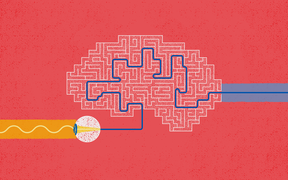The limits of vision: seeing shadows in the dark

Mice use a specific neural pathway to detect shadows, and it can detect just about the dimmest shadows possible, according to new research from Aalto University and the University of Helsinki. The human eye has the same neural circuit, which researchers think could be used to probe visual diseases at unprecedented resolution.
To test shadow detection, the researchers put mice in a maze with nearly no light. The exit was marked by a black spot, just barely distinct from the surrounding darkness. By tracking how the mice moved through the maze and measuring the activity of neurons at the back of the eye – the retina – the team showed that a group of retinal cells known as OFF ganglion cells detected the extremely small dip in light levels.
‘Our goal is to go from molecules all the way up to behaviour,’ says Professor Petri Ala-Laurila, who holds a joint appointment at Aalto and the University of Helsinki. This study builds on earlier work from his group which showed that ON ganglion cells are used to detect a very faint patch of light in darkness. ‘The opposite task would be detecting the dimmest shadows, where just a few photons are missing. Our hypothesis was that that’s what the most sensitive OFF cells do in starlight, because they increase their firing rate in response to shadows,’ says Ala-Laurila.
The team also calculated the fundamental limit of shadow detection based on the physical properties of the light receptors and neural pathways. After accounting for unavoidable losses – for example, not every photon that hits a receptor gets absorbed – they found that the behaviour and the retinal activity of the mice came very close to a perfect response. ‘Our tightly constrained modeling highlights that both visually-guided behavior and the most sensitive OFF ganglion cells are almost perfect shadow detectors,’ says Dr. Johan Westö, one of the joint first authors of the study.
The research had to be done in nearly complete darkness in order to detect these differences. Nataliia Martyniuk, the study’s other first author, says that ‘the exquisite sensitivity of the visual system to the dimmest shadows sets high technical demands for the experiments that we carried out at these extremely low light levels.’ At higher light levels, many more retinal circuits become activated, which would have made the analysis prohibitively challenging.
‘Insanely dim shadows can be detected! Even just a couple of photons missing from a few thousand rod receptors is enough for the animals to detect a shadow,’ says Ala-Laurila. ‘That probably relates to the huge evolutionary need to detect shadows because mice and other animals have evolved to avoid predators at really low light levels.’
These findings show how the process of making sense of incoming light – turning it into a mental picture – is distributed across different cell types that carry out different computational tasks in the retina. Within the eye, input from thousands of receptors cascades up to ON and OFF ganglion cells, which act as modules to specifically detect light and shadows, respectively.
‘That pushes a lot of computation onto the retina, and doing this detection early on simplifies the task for downstream processes in the brain,’ says Ala-Laurila. ‘We can demonstrate this principle in the eye at very low light levels. My guess is that it also applies at higher light levels and in other senses and other areas of neurobiology.’
The retinal circuit responsible for conveying information to ON and OFF ganglion cells is nearly identical in humans. Ala-Laurila explains that the ability to test the function of retinal cell-types specifically in starlight could also have clinical implications. Many visual diseases are specific to particular cell-types in the retina. By carrying out tests at very low light levels, it might be possible to detect such diseases earlier and with greater precision, since at those light levels every photon counts. ‘In my lifetime, I want to see revolutionary techniques for detecting visual diseases using very low light levels as a tool,’ he says.
Contact
Studying vision in pitch-darkness shines light on how a mammal’s brain drives behaviour
Neuroscientists link mammalian behaviour to its underlying neural code at the unprecedented resolution of individual nerve impulses for the first time.

Finding your way in the dark depends on your internal clock
Surprising results show how circadian rhythm changes the way mammals can see

Read more news

Aalto University to host INNOVA Europe 2026 Grand Final in Espoo
Aalto University will host the INNOVA Europe 2026 Grand Final in Espoo, bringing together leading student-led startups from European universities.
Finnish AI Region Secures Second Term with Top Marks from EU
Finnish AI Region (FAIR) EDIH has been selected to continue operations for a second term with excellent ratings. European Union continuation funding enables service expansion from the beginning of 2026. Aalto University is one of 10 partners in FAIR.
Unite! Seed Fund 2026: Open for applications
The 2026 Unite! Seed Fund call is officially open, offering funding across three strategic lines: Student Activities, Teaching and Learning, and Research and PhD. Deadline for applications is 20 March 2026.






